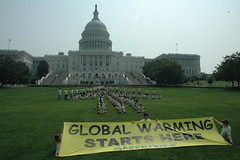This excellent essay was posted at DKos on Tuesday. Its author, “the Cunctator” has registered for DD and will be here soon!
Is Lieberman-Warner a “Strong” Climate Bill?
by The Cunctator
Friends of the Earth challenged Sen. Boxer to support legislation that resembles the Democratic presidential candidates’ platforms for climate change legislation, not the Lieberman-Warner bill.
Boxer called Friends of the Earth “defeatist.” FoE responded: “We’re being realists.”
ASiegel then wrote: Boxing our way to disaster looking for an “explanation for her strong championing of the fatally-flawed Lieberman-Warner Climate (in) Security Act”.
Then Environmental Defense leaped to attack Friends of the Earth and ASiegel.
Boxer calls the committee passage of Lieberman-Warner the “greatest legislative accomplishment of my political career of thirty years”.
ED and NWF call L-W “a strong bill.” NRDC calls L-W “a very strong start.” The Nature Conservancy calls L-W “a strong starting point.”
So who’s right? Let’s take a step outside the Beltway and check in with some facts.
Is L-W a “good” bill?
The proper metrics to judge mandatory CO2-emissions-reduction legislation such as L-W are:
1. effectiveness in reducing emissions
2. effect on economy/society
So, how does L-W rate?
Effectiveness in Reducing Emissions
On the first, the IPCC 4th Assessment Report says that a long-term stabilization target of 2°C above pre-industrial levels is needed to have an even chance at avoiding the tipping point into catastrophic climate change.
The report also says that to achieve that target, the industrialized nations need to cut emissions to 25-40% below 1990 levels by 2020, and 80-95% below 1990 levels by 2050.
(Developing nations need to simultaneously achieve “substantial deviation from baseline” for overall reductions to be sufficient. See Box 13.7 in the 4th Assessment Report, p. 776.)
L-W is not close to either of these targets. L-W only covers 80% of emissions. For covered sectors, it hits 1990 levels by 2020 and 65% below 1990 levels by 2050.
At Bali, the Annex I Kyoto signatories (every single industrialized nation except the US and Turkey) agreed to the IPCC targets. The EU has unilaterally committed to achieving 20% reductions from 1990 levels by 2020, and would shoot for 30% reductions if the US makes a comparable effort.
Again: Lieberman-Warner is expected to achieve 1990 levels by 2020, and 56% below 1990 levels by 2050.
So, even assuming that the legislation is well designed and will be well implemented such that the targets in the bill will be met, if by “perfect” one means “an even chance of avoiding catastrophic climate change”, L-W is not perfect in its targets.
Furthermore, its lookback and cap-adjustment provisions are heavily weighted towards short-term economic growth instead of scientific necessity or long-term economic health.
Is L-W good? Is it “strong”? ED, which did not publicly support the Sanders amendments in committee to strengthen the cap targets and lookback provisions, evidently thinks so. I’m not sure what science they’re using to come up with that result.
Similarly, NRDC has said “Effective legislation must be enacted soon to avoid a 2 degree Celsius temperature increase.” I’m not sure what science they’re using to consider L-W “effective legislation.”
Effect on Economy and Society
In this analysis, I am going to make two a priori assumptions:
1. Catastrophic climate change would be worse for our economy and society than doing nothing
2. some mandatory regulatory system will be put in place
In other words, I’m comparing L-W’s economic effect against other hypothetical emissions reduction programs, not against the do-nothing scenario.
There is a well-developed consensus for some of the elements necessary to a “perfect” regulatory system, following principles of economic efficiency (maximum benefit to sector-wide industry and businesses) and economic justice (job creation, benefit to poor and middle class, etc.).
These include:
1. 100% auction of credits
2. Auction proceeds should go into minimizing economic disruption and investing in energy efficiency, renewable energy and other emissions-reduction technology, sustainable agriculture, and international/local mitigation/adaptation
3. To minimize economic disruption: Most efficient system is to make overall tax system more progressive (possibly improving other safety net systems like healthcare)
1. Allocation of about 15% of auction to poorest 20% (preferably by reducing existing taxes, such as payroll taxes) protects them from harm
2. About 6% of auction revenues sufficient to protect electricity producing sector from harm; can be phased out over time
3. Similarly for other covered sectors
4. Energy efficiency:
1. Short-term emphasis should be more on energy efficiency than new-tech investment (see Architecture 2030) — free allocations to load-serving entities would block/slow this
2. Smart grid/electranet/distributed grid should be emphasized — support for traditional power system will block/slow this development
3. Mass transit, smart growth, high-density urban planning should be emphasized — subsidization for traditional highway system, etc. with block/slow this
5. Technology investment:
1. no more than $8-$30 billion over 10 years needed to spur carbon-capture and sequestration technology
2. Subsidization of renewable energy technology should be at least on par with subsidization for nuclear, natural gas, coal, oil. Would make sense to actually be more strongly subsidized. Would make sense to reduce/remove subsidies for gas/coal/oil that aren’t emissions-reduction focused.
6. Agriculture:
1. Sustainable agricultural practices (high-carbon farming, local farming, etc.) should be supported — subsidies for industrial agriculture blocks/slows this
2. Biofuels need to be locally and sustainably produced and used to have a net positive effect
7. International mitigation and adaptation support — I’m not sure what the “perfect” system is here, but I know that, for example, the Nature Conservancy wants a real emphasis on preventing deforestation
Now, L-W is not “perfect” on any of these. In fact, it has nearly the exact opposite emphasis in most categories. Over its 4-decade span, allocates about 48% of the permits away for free, giving 22% directly to polluting entities. These giveaways are heavily frontloaded. About $350 billion is allocated to supporting CCS (also frontloaded). It lumps nuclear and “clean coal” tech with renewable energy. It allocates permits for free to load-serving entities. It allocates permits for free to state governments (guaranteed to make pricing more inefficient).
The ED and other groups like to argue that we shouldn’t make the perfect the enemy of the good. It’s also to remember that the bad is necessarily the enemy of the good.
It is possible to reform the existing framework in the L-W legislation, in my opinion, to arrive at a bill that is “good”. It certainly wouldn’t be perfect.
Perfect climate legislation requires:
1. 100% coverage of emitters, not 75-80%
2. Climate-positive / carbon-negative targets–actually reducing greenhouse gas concentrations in the atmosphere
3. Transformative reform of existing agriculture/land-use policy
4. Transformative reform of existing transportation policy
5. Transformative reform of existing tax policy
6. Transformative reform of existing resource extraction policy
7. Transformative reform of existing electricity distribution policy
So the best that a single cap-and-trade policy can be is “good”. As Al Gore outlined a year ago, a comprehensive and effective climate policy merely starts with a strong cap-and-trade system.
By reasonable economic and scientific metrics, L-W is not a good bill unless you own coal and/or nuclear plants or belong to an investment bank.
 the Democratic Radio Address.
the Democratic Radio Address.
